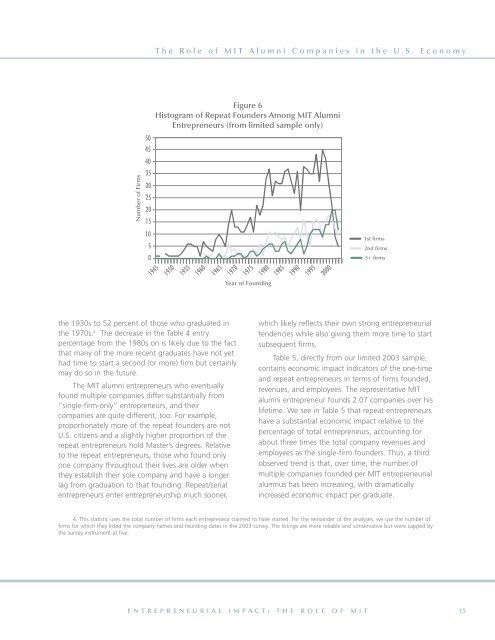mit_impact_full_report
mit_impact_full_report
mit_impact_full_report
You also want an ePaper? Increase the reach of your titles
YUMPU automatically turns print PDFs into web optimized ePapers that Google loves.
Number of Firms<br />
50<br />
45<br />
40<br />
35<br />
30<br />
25<br />
20<br />
15<br />
10<br />
5<br />
0<br />
The Role of MIT Alumni Companies in the U.S. Economy<br />
Figure 6<br />
Histogram of Repeat Founders Among MIT Alumni<br />
Entrepreneurs (from li<strong>mit</strong>ed sample only)<br />
1945<br />
1950<br />
1955<br />
1960<br />
1965<br />
the 1930s to 52 percent of those who graduated in<br />
the 1970s. 4 The decrease in the Table 4 entry<br />
percentage from the 1980s on is likely due to the fact<br />
that many of the more recent graduates have not yet<br />
had time to start a second (or more) firm but certainly<br />
may do so in the future.<br />
The MIT alumni entrepreneurs who eventually<br />
found multiple companies differ substantially from<br />
“single-firm-only” entrepreneurs, and their<br />
companies are quite different, too. For example,<br />
proportionately more of the repeat founders are not<br />
U.S. citizens and a slightly higher proportion of the<br />
repeat entrepreneurs hold Master’s degrees. Relative<br />
to the repeat entrepreneurs, those who found only<br />
one company throughout their lives are older when<br />
they establish their sole company and have a longer<br />
lag from graduation to that founding. Repeat/serial<br />
entrepreneurs enter entrepreneurship much sooner,<br />
1970<br />
1975<br />
Year of Founding<br />
1980<br />
1985<br />
1990<br />
1995<br />
2000<br />
1st firms<br />
2nd firms<br />
3+ firms<br />
which likely reflects their own strong entrepreneurial<br />
tendencies while also giving them more time to start<br />
subsequent firms.<br />
Table 5, directly from our li<strong>mit</strong>ed 2003 sample,<br />
contains economic <strong>impact</strong> indicators of the one-time<br />
and repeat entrepreneurs in terms of firms founded,<br />
revenues, and employees. The representative MIT<br />
alumni entrepreneur founds 2.07 companies over his<br />
lifetime. We see in Table 5 that repeat entrepreneurs<br />
have a substantial economic <strong>impact</strong> relative to the<br />
percentage of total entrepreneurs, accounting for<br />
about three times the total company revenues and<br />
employees as the single-firm founders. Thus, a third<br />
observed trend is that, over time, the number of<br />
multiple companies founded per MIT entrepreneurial<br />
alumnus has been increasing, with dramatically<br />
increased economic <strong>impact</strong> per graduate.<br />
4. This statistic uses the total number of firms each entrepreneur claimed to have started. For the remainder of the analyses, we use the number of<br />
firms for which they listed the company names and founding dates in the 2003 survey. The listings are more reliable and conservative but were capped by<br />
the survey instrument at five.<br />
ENTREPRENEURIAL IMPACT: THE ROLE OF MIT 15



